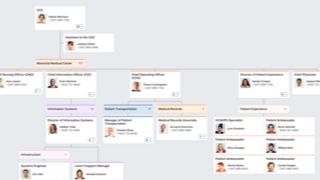Hospital Organizational Chart Example
We’ve put together an example org chart for hospitals that illustrates the main departments and their most common roles. Try the interactive org chart below to see how best to display the essential departments, roles, and skills of your hospital employees.
Build Your Org ChartReady to get started?
Download the Hospital org chart template above, add your own employee data, and Import into Pingboard. Note: you’ll need a Pingboard account first. Sign up for a free trial.
Pro Tip You can build your org chart automatically. Instead of filling out a spreadsheet, you can connect your HR system to Pingboard to automatically sync employee data. Your org chart will get updated automatically every time a change happens. We integrate with ADP, Azure, BambooHR, Google Apps, Namely, Okta, and more.
Below are some brief descriptions of common roles in hospitals and their key responsibilities.
Hospital CEO
Long-term goals are typically set by a hospital’s board of directors, and then the CEO puts those plans into action. As you probably expect, you’ll find the CEO at the top of the org chart.
A hospital CEO’s main responsibilities include:
- Reviewing best practices for each department to ensure the highest quality of care is provided to patient.
- Ensuring the hospital complies with Federal, State, and CMS (Centers for Medicare & Medicaid Services) standards.
- Making viable financial decisions around overall policies and strategy.
- Promoting a rewarding, engaging, safe, and fun environment to attract new staff and retain current employees.
Chief Medical Officer
The fundamental job of the Chief Medical Officer (CMO) is to supervise the medical, nursing, case management, pharmacy, and quality functions of Central Health departments. CMOs work with hospital team leads to plan, implement and manage clinical operations, including the development of population health management strategies and new strategic clinical initiatives.
Here are a few other things hospital CMOs are tasked with:
- Aligning clinical resources to organizational goals and objectives to optimize the health of the covered population and improve clinical outcomes.
- Leading the development of hospitals’ social work infrastructure to emphasize improved outcomes and optimal transitions of care.
- Determining quality healthcare metrics for hospitals so they can review and assess patient health outcomes,experience, and cost of care.
- Serving as a liaison to stakeholders including partner agencies, community healthcare providers, elected officials, governing bodies, and media outlets.
- Monitoring healthcare departments’ budgets.
Director of Patient Experience
The Director of Patient (or Hospital) Experience communicates with patients, family members, visitors, physicians, and the hospital staff to constantly improve interactions between those receiving care and the hospital.
The Patient Experience Director is responsible for:
- Working with staff and leadership to develop and implement a formal model of communication throughout the facility.
- Teaching communication strategies to staff for vital interactions, including:
- Patient rounds
- Care calls
- Managing subordinates and effective employee communication
- Service recovery
- Auditing Patient Satisfaction Scores and providing consultation / resources to department leaders to improve the lowest scores
- Raising HCAHPS survey scores to increase chances of receiving more government funding
Chief Medical Information Officer
The Chief Medical Information Officer (CMIO) is responsible for leadership, vision, and setting a strategic direction for IT systems & electronic medical records. By identifying opportunities and implementing change, the CMIO will lead IT to deliver reliability to the organization and support the mission, vision, and goals of the hospital.
The CMIO is also responsible for:
- Providing strategic and tactical planning, development, evaluation, and coordination of the information and technology systems for the hospital
- Managing multiple information and communications systems and projects, including voice, data, imaging, and office automation
- Researching and leading the hospital in IT investments
- Developing and implementing software training programs for hospital staff
- Overseeing and evaluating system security and backup procedures to protect sensitive patient data
Director of EVS
The Director of EVS (Environmental Services) is responsible for cleanliness and infection prevention protocol at a hospital.
Other responsibilities of the director of EVS include:
- Establishing and implementing policies and procedures for departmental operations so the hospital meets industry standards
- Coordinating housekeeping activities and best practices with all hospital departments
- Developing departmental operating budgets
- Hiring, retaining, and training EVS team members on chemical and infection safety standards
- Staying up to date with industry standards, and continuously making improvements around infection prevention and control
